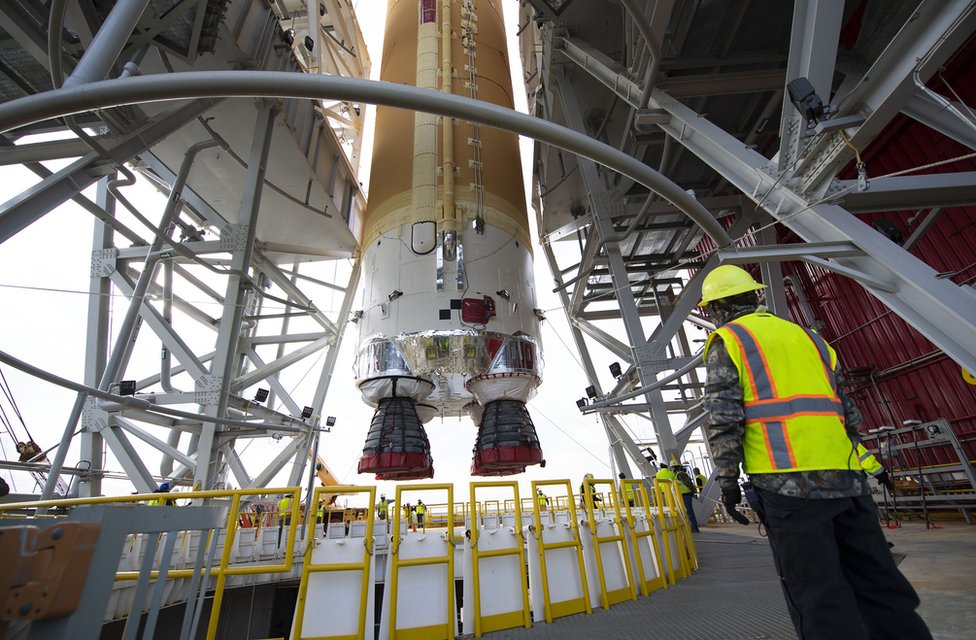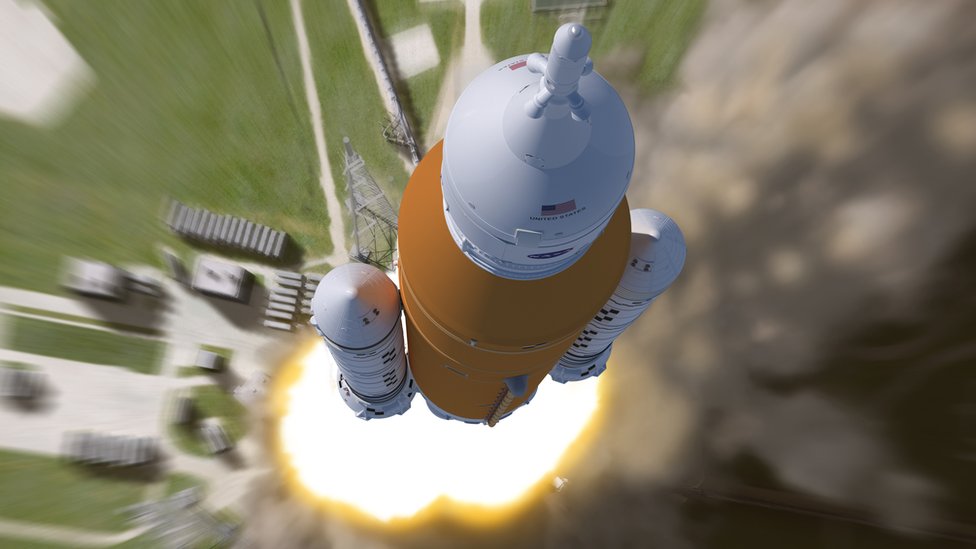
image copyrightNASA / Jude Guidry
The four main engines of Nasa’s new “megarocket” are to be fired in unison for the first time, demonstrating the launcher’s raw, explosive power.
The Space Launch System (SLS) is part of the US space agency’s Artemis programme, which aims to put Americans back on the lunar surface by 2024.
The engine “hotfire” is the last in a series of tests known as the Green Run.
It will help Nasa certify the rocket for its maiden flight, scheduled to take place later this year.
This uncrewed mission, called Artemis-1, will launch Nasa’s next generation spacecraft, Orion, on a loop around the Moon.
Saturday’s eight-minute ground test – due to take place within a two-hour window from 22:00-00:00 GMT – is designed to simulate the rocket’s climb to orbit.
The core stage will be anchored to a steel structure called the B-2 test stand on the grounds of Nasa’s Stennis Space Center near Bay St Louis, Mississippi.
Once ignited, the four RS-25 engines at the base of the core will generate 1.6 million lbs (7 Meganewtons) of thrust – the force that propels a rocket through the air.
“It’s a full-duration burn – that’s what we’re targeting,” Ryan McKibben, Green Run test conductor at Nasa Stennis, told BBC News.
“Doing a whole stage test versus a single engine test is definitely exciting,” he said, adding: “It’s a unique opportunity to test drive the core stage for the first time.”

image copyrightNASA
The hotfire is the eighth and final test in the Green Run, a programme of evaluation carried out by engineers from Nasa and Boeing – the rocket’s prime contractor.
“It’s been a very cautious iteration of procedures that has got us to this stage,” said John Shannon, vice president and SLS program manager at Boeing.
“It’s not a developmental or test article, it’s the flight article that will power Artemis-1 around the Moon, so we’re being very careful with it as we go.”
The engines have already made history. They’re the same type that used to power the space shuttle orbiter, and Nasa will re-use flown hardware for the first four SLS launches.
The SLS consists of the huge core stage with two smaller solid rocket boosters (SRBs) attached to the sides. Engineers have begun stacking the individual SRB segments at Kennedy Space Center in Florida, ahead of the launcher’s first flight at the end of 2021.
“This powerful rocket is going to put us in a position to be ready to support the agency and the country in deep space missions to the Moon and beyond,” John Honeycutt, SLS programme manager at Nasa’s Marshall Space Flight Center in Huntsville, Alabama, said during a media briefing on Tuesday.
Before the hotfire, engineers will fill the core stage with more than 700,000 gallons (3.2 million litres) of propellant.

image copyrightNASA
That propellant consists of liquid hydrogen, which is the rocket’s fuel, and liquid oxygen, which helps the fuel burn. They react explosively inside the engines, generating super-heated water vapour from the exhaust.
Hydrogen and oxygen are gaseous at room temperature, but gases take up lots of space. Turning them into liquids allows an equivalent amount to be stored in a smaller tank, but also requires them to be chilled to super-cold temperatures.
They enter the engines at several hundred degrees below zero, but the exhaust that emerges at the other end is 6,000F (3,315C) – hot enough to boil iron.
“We fire down into a bucket that has a lot of water going into it. The water keeps it from burning straight through the test stand,” Ryan McKibben told BBC News.
Hundreds of thousands of gallons of water are directed into the flame bucket to cool the exhaust. In addition, tens of thousands of gallons will be used to create a water “curtain” around the engines to suppress the noise generated when they fire for eight minutes.
This is done to protect the core stage from vibrations while it is anchored to the stand.
Over 1,400 sensors will measure how the rocket’s systems are performing during the test.

“With this hotfire, there’s a lot of data – including how the avionics (flight electronics) and software command and control will perform with the integrated core stage and engine propulsion system which will fire all four engines,” said Julie Bassler, SLS stages manager at Marshall Space Flight Center.
Nasa wants to iron out any problems before next year’s Artemis 1 mission. If all goes well, the SLS will also launch astronauts to the Moon for the first human landing since Apollo 17 in 1972.
Although the target is to fire the engines for eight minutes – around the time it takes for the SLS to get to orbit – Nasa and Boeing get all the engineering data they need in order to certify the rocket for flight within the first four minutes of the test.
A full duration burn, however, will allow experts to observe the engine cut-off, which occurs after almost all the propellant has drained from the run lines.
Once the hotfire test is complete, technicians will refurbish the core stage, remove it from the test stand and prepare it for transport to Nasa’s Kennedy Space Center in Florida.

image copyrightNASA
Officials want to ship the rocket segment in February to Kennedy Space Center, where it will be prepared for launch.
The engines being tested on Saturday contributed to 21 successful shuttle flights over the vehicle’s 30-year operational history.
Two were used on the last space shuttle mission, STS-135 in 2011. One flew on the 1998 mission that launched the oldest person ever to go to space – US senator and Project Mercury astronaut John Glenn, who was 77 at the time. The other was used on one of the flights to service the Hubble Space Telescope.
The engines were refurbished following shuttle missions, but they will be discarded after Artemis-1.
“Since they’re one-way now, they’re letting us push the engines to a little higher power level because we can wear the engines a little bit more,” said Ryan McKibben.
Aerojet Rocketdyne is developing new versions of the RS-25, built with innovative manufacturing techniques, that will be used on future flights of the SLS.
Follow Paul
Read MoreFeedzy


